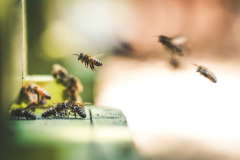13 Amazing Facts to Learn About Bees
1. There are some benefits to a bee sting
Melittin is a toxin found in bee venom that may prevent the HIV virus. Melittin pokes openings into the protective envelope of the virus, killing HIV. As melittin makes it way around on nanoparticles, its normal cells are left alone, bouncing off of them leaving them unharmed. There are hopes from researchers at Washington University located in St. Louis that this toxin can someday be utilized in a preventative gel.
Scientists from the University of Sao Paulo have also found that levels of the anti-inflammatory hormone, glucocorticoid, are increased by molecules in bee venom.
2. Bees work themselves to death
Worker bees have the ability to live up to nine months during chillier seasons. However, during the summer, it is uncommon for these bees to last more than six weeks because of how hard they work.
3. Medicine is changing because of bees
Propolis, a resin from evergreen and poplar trees is used by bees to reinforce their hives. Basically, propolis is beehive glue. While bees use this resin as caulk, it is used by humans to fight off viruses, fungi, and bacteria. Research has found that propolis, when taken directly from the beehive, may relieve a sore throat, canker sores, cold sores, herpes, eczema, and cavities.
4. As a bee changes jobs, the chemistry of their brain is changed as well
Bees are genetically predisposed to do specific jobs. For example, scout bees are predisposed to search for food sources. Soldier bees work their entire life as a security guard. A genetic pattern compels about one percent of older bees to work as undertakers, removing dead bees from the beehive. Regular honeybees, however, perform numerous jobs during their lifetime. Prior to beginning a new job, the brain chemistry of these honeybees change.
5. The brain of a bee defies time
The brain of an aging bee stops aging when performing jobs usually kept for younger bees. In fact, the brain of these bees age in reverse. According to scientists from Arizona State University, this discovery may be helpful in slowing down the beginning of dementia.
6. Bees create jobs
Each year, about 285 million pounds of honey are consumed by Americans. Furthermore, according to the U.S. Department of Agriculture, about 80 percent of the nation’s insect crops are pollinated from honeybees; meaning, more than $20 billion worth of insect crops are pollinated from bees each year.
7. Bees distinguish human faces
In a similar way that we do, honeybees make out faces. They put together parts, such as ears, lips, and eyebrows, and identify the entire face. This process is called configure processing and according to the New York Times, it may be helpful in improving the technology used for face recognition.
8. Bees have personalities
Like humans, there are worker bees and shirker bees. Studies taken place at the University of Illinois have found all bees are not identical. There are ones that are timid, while others are thrill-seekers. A study in 2011, found honeybees to be pessimistic when agitated. This leads scientists to believe that bees may have feelings.
9. Bees have the ability to solve complex mathematical problems
Consider
it
is
Saturday
afternoon,
and
you
have
errands
to
run.
You
must
visit
five
stores
at
five
various
locations.
While
visiting
all
five
locations,
what
is
the
shortest
route
you
can
travel?
This
is
called
the
“traveling
salesman
problem”
to
mathematicians
and
can
even
be
difficult
for
some
computers.
However,
this
is
easy
for
bumblebees.
Studies
at
Royal
Holloway
University
in
London
have
shown
that
bumblebees
choose
the
shortest
route
possible
to
fly
between
flowers.
Bees
are
the
only
animal
so
far
to
solve
this
problem.
10. Bees get a buzz from cocaine and caffeine
Caffeine is a defense chemical in plants that drives away harmful insects while luring in pollinators. Researchers from Newcastle University have found that caffeine-laced nectar helps a bee remember the location of the flower resulting in an increased chance of return visits.
Bees work better with caffeine, and cocaine encourages them to lie. Bees communicate through “dance”, giving other bees the location of good food. However, honeybees high from cocaine amplify their “dance” moves and exaggerate the quality of the food. Withdrawal symptoms are also exhibited, helping scientists comprehend the degrees of addiction.
11. Bees can help law enforcement find serial killers
Serial killers and bees behave in similar ways. Crimes committed by serial killers are close to home, but at a safe enough distance as to not raise suspicion with neighbors. Similarly, a bee collects pollen close to the hive, but at a safe enough distance to not attract predators to their hive. To learn about this “buffer zone” and how it works, scientists researched the behavior of bees and wrote some algorithms. Findings from this research improved computer models used by law enforcement to find felons.
12. Bees use a system similar to the Vikings
The sun is a bee’s compass. However, when it is cloudy, bees find their way around by polarized light, finding the location of the sun by utilizing special photoreceptors. A similar system was used by the Vikings: They navigated by the use of sundials on sunny days and sunstones on cloudy days. Sunstones are hunks of calcite and act similar to a polaroid filter.
13. Bees are the world’s most economical creators
Marcus Terentius Varro in 36 B.C., stated that honeycombs are the most sensible structures known. This conjecture was solidified centuries later by Pappus, a Greek mathematician. Now, 2000 years later, the 19-page mathematical proof was written by Thomas Hales, showing honeycombs use the smallest amount of wax when compared with all possible structures. In addition to being the most efficient structure, the walls of a honeycomb make a perfect hexagon meet precisely at a 120-degree angle.


